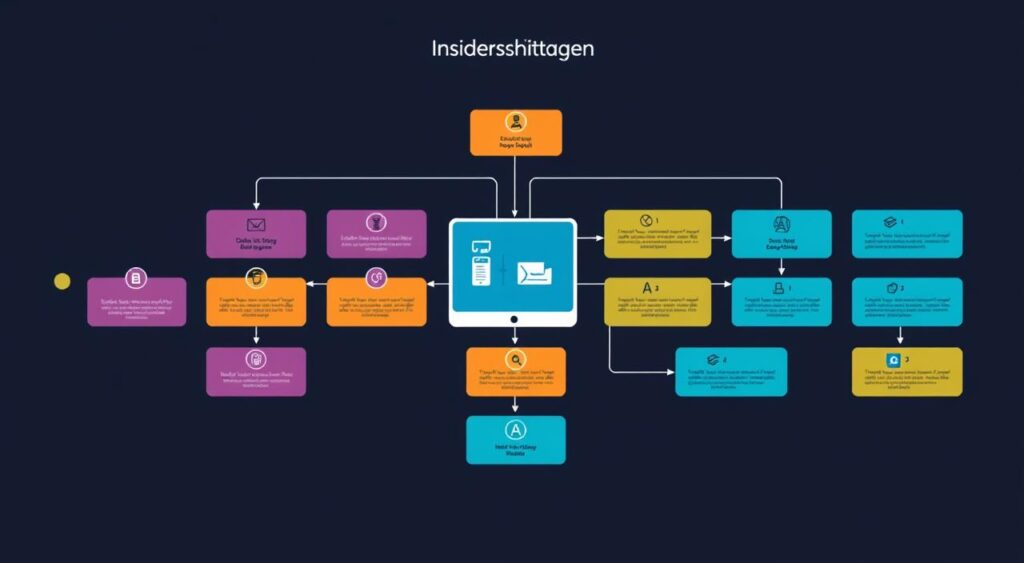Did you know over 93% of online experiences start with a search engine? Mastering search engine optimization (SEO) is key to making your website stand out. This guide will explore a wide range of SEO strategies and techniques to boost your website’s visibility.
We’ll cover everything from basic keyword research to advanced on-page and off-page optimization. You’ll learn proven methods to improve your search engine ranking and outshine competitors. Whether you’re new to SEO or experienced, this article will give you the tools and knowledge to enhance your website’s performance.

Key Takeaways
- Discover the fundamentals of SEO and why it’s crucial for your website’s success
- Learn how to conduct effective keyword research to target the right audience
- Explore on-page optimization techniques to enhance your website’s content and structure
- Understand the importance of technical SEO factors, such as site speed and mobile-friendliness
- Leverage off-page SEO strategies, including link building and social media promotion
- Optimize your website for local SEO to reach customers in your geographic area
- Measure and analyze your SEO performance to make informed decisions
Understanding the Fundamentals of SEO
Search Engine Optimization, or SEO, is the art and science of making your website more visible. It helps your site rank higher in search engine results. This is key for any online marketing strategy, as it draws in more targeted traffic.
What is SEO?
SEO is about knowing how search engines work. Then, you use that knowledge to improve your website’s content and structure. The aim is to make your site more appealing to search engines, so it shows up higher in search results.
Why is SEO Important for Your Website?
Effective SEO offers many benefits to your website and business:
- Increased Visibility – Better search engine rankings mean more people see and visit your site. This boosts brand awareness and attracts more potential customers.
- Targeted Traffic – SEO draws in people actively looking for what you offer. This is better than broad, untargeted marketing.
- Competitive Advantage – Optimizing your site for search engines gives you an edge over competitors who may not focus on SEO.
- Long-Term Results – The benefits of SEO grow over time. Your website’s authority and relevance increase, leading to more traffic.
By grasping the basics of SEO and using best practices, you can boost your website’s discoverability. This attracts more valuable, high-intent traffic from search engines.

Keyword Research: The Foundation of SEO
Starting a good SEO plan means doing deep keyword research. This step is key to finding the right keywords for your business. It includes long-tail keywords and knowing what users search for. With good keyword research, you can make sure your content meets your audience’s needs.
Good keyword research for SEO is more than just finding popular words. It’s about knowing what your customers want. Finding the right keywords helps bring more people to your site and makes it easier to find in search results.
Looking for long-tail keywords is a smart move. These are specific, less competitive phrases that draw in targeted traffic. They show what your audience is really looking for, giving you insight into their interests.
| Keyword Type | Description | Example |
|---|---|---|
| Short-tail Keywords | Broad, high-volume search terms | “SEO strategies” |
| Long-tail Keywords | Specific, lower-volume search phrases | “how to optimize website for SEO” |
Knowing keyword intent helps you make content that meets your audience’s needs. This can help you rank higher in search results and get more qualified visitors to your site.

Getting good at keyword research is key for any SEO plan. By finding the best keywords, you can make content that speaks to your audience. This helps optimize your site and boosts your visibility and traffic.
On-Page SEO Optimization Techniques
Improving your website’s visibility in search engines is key. Focus on making page titles and meta descriptions compelling. Also, create content that is both engaging and rich in keywords.
Optimizing Page Titles and Meta Descriptions
Page titles and meta descriptions are crucial. They are the first thing users see in search results. They help in on-page SEO by making your site more appealing to click on.
Make sure your titles are short, descriptive, and include important keyword-rich content. Your meta descriptions should match the page’s content and include target keywords.
Creating Compelling and Keyword-Rich Content
Your website’s content quality and relevance are vital for content optimization and on-page SEO. Create content that is informative, valuable, and keyword-rich. It should meet your audience’s needs and interests.
Use your target keywords naturally in the text. This ensures a smooth flow and high content quality. By focusing on on-page SEO and quality content, you can boost your website’s visibility and engagement.

Enhancing Website Structure and Navigation
Your website’s structure and navigation are key for Search Engine Optimization (SEO). Making your site architecture better and your user-friendly navigation can really help. This improves how search engines see your site, making it easier for users to find what they need.
Improving Site Architecture
A good site architecture is the base of a great website. It means organizing your content in a clear, organized way. This makes it easier for search engines to understand and index your site. It also helps with internal linking, which is important for SEO.
To make your site architecture better, try these tips:
- Make a clear and easy-to-use information hierarchy. Put your most important pages right on the homepage.
- Use a silo structure to group related content together. This helps search engines understand your site better.
- Use internal linking to help users and search engines find the best content on your site.
Creating a User-Friendly Navigation
A good user-friendly navigation is just as important as a good site structure. It helps both your visitors and search engines. A clear menu makes it easy for users to find what they need, improving their experience.
Here are some tips for designing your navigation:
- Organize your main menu based on your site’s structure and content.
- Use clear, keyword-rich labels for your links to help with SEO.
- Make sure your navigation works well on all devices, including mobiles.
- Use breadcrumb navigation to help users see where they are on your site.
By improving your site architecture and website navigation, you make your site better for users and search engines. These changes can help your site get more visibility, engagement, and traffic.

| Strategies for Improving Site Architecture | Strategies for Creating User-Friendly Navigation |
|---|---|
| Establish a clear information hierarchyImplement a silo structureLeverage internal linking | Organize navigation based on site hierarchyUse descriptive, keyword-rich labelsEnsure responsiveness and mobile-friendlinessImplement breadcrumb navigation |
Optimizing Images and Multimedia for SEO
Improving your website’s search engine ranking is key. Image optimization and video optimization play a big role. They help grab your audience’s attention and make your site more user-friendly.
Proper alt text for images is crucial. Alt text gives a text description of the image. It helps search engines and screen readers, making your site more accessible. This also boosts your chances of showing up in image search results.
Don’t overlook the importance of file names. Use descriptive and keyword-rich file names for better multimedia SEO. Search engines use this info to understand your images and videos.
- Optimize image file sizes to improve page load times
- Incorporate relevant keywords in image alt text and file names
- Leverage video transcripts and captions to enhance searchability
- Ensure your multimedia content is mobile-friendly and responsive
“Optimizing your images and multimedia content is a powerful way to elevate your website’s search engine visibility and provide a seamless user experience.”
By optimizing your images and videos, you can make the most of your multimedia. This will bring more relevant visitors to your site.

Technical SEO Factors for Better Rankings
Optimizing your website’s technical aspects can greatly improve its visibility in search engines. Factors like website speed and mobile-friendly design are key. They help your site rank higher and offer a better experience for visitors.
Website Speed Optimization
Website speed is very important to search engines like Google. Slow sites can hurt user experience and lead to more people leaving quickly. To make your site faster, try these tips:
- Use smaller images, videos, and media to speed up page loads.
- Use browser caching to make repeat visits faster.
- Optimize your site’s code to make it load quicker.
- Use a Content Delivery Network (CDN) to serve assets closer to users.
Mobile-Friendly Design
In today’s world, having a mobile-friendly website is essential. Search engines favor sites that work well on mobile devices. Make sure your site looks good and works well on all devices for a great user experience.
| Metric | Non-Mobile Optimized | Mobile Optimized |
|---|---|---|
| Bounce Rate | 58% | 42% |
| Average Time on Site | 2 minutes | 4 minutes |
| Conversion Rate | 12% | 25% |
By focusing on these technical SEO factors, you can make your site easier for search engines to crawl. This will improve user experience and boost your rankings. More people will find your site, bringing in more qualified visitors.

SEO
In the world of search engine optimization, off-page SEO is key to making your website more visible and trusted. On-page optimization focuses on your website’s content and structure. But off-page SEO is about what happens outside your website. Let’s look at some powerful ways to boost your online presence.
Building Quality Backlinks
Getting high-quality backlinks is at the heart of off-page SEO. These are links from other reputable websites that lead back to yours. They show search engines that your content is trustworthy and deserves to rank high.
- Leverage guest posting to write for top blogs and publications.
- Do link building outreach to get links from other websites.
- Make sure your business is listed on local directories and review sites.
Harnessing the Power of Social Signals
Social media is now a big player in off-page SEO. Being active on social networks and getting people to engage with your content can send strong social signals. These signals tell search engines your content is relevant and popular.
| Social Platform | Potential Impact on SEO |
|---|---|
| Shares, likes, and comments can boost your visibility and authority. | |
| Retweets, mentions, and engagement can signal the value of your content. | |
| Connections, shares, and industry-relevant discussions can enhance your professional reputation. |
By getting good at off-page SEO, you can improve your website’s ranking in search results. This leads to more traffic, leads, and business growth.
Off-Page SEO Strategies
On-page SEO focuses on your website’s content and structure. Off-page SEO involves activities outside your website. These efforts can greatly improve your site’s authority and visibility in search results. Let’s look at two key strategies: building quality backlinks and using social media marketing.
Building Quality Backlinks
Getting high-quality backlinks is a key off-page SEO tactic. Backlinks are links from other sites to yours, seen as endorsements by search engines. Getting links from trusted, relevant sites can boost your ranking and off-page SEO. Techniques like guest posting, link building, and outreach can strengthen your backlink profile.
Social Media Marketing and Promotion
Social media is crucial in today’s digital world for off-page SEO. Engaging with your audience on social media can increase social signals and website traffic. Sharing content, joining discussions, and building a loyal following can improve your online presence and reputation. This can lead to better search engine rankings.
| Off-Page SEO Tactic | Benefits |
|---|---|
| Link Building | Improved search engine authority and credibility |
| Guest Posting | Increased brand awareness and referral traffic |
| Social Media Marketing | Enhanced social signals and audience engagement |
Using these off-page SEO strategies can greatly improve your website’s visibility and authority. A balanced SEO approach that includes both on-page and off-page tactics is key for lasting success.
Local SEO: Targeting Local Customers
For businesses in a specific area, local SEO is key. It helps attract more local customers and increase foot traffic. We’ll look at how to boost your local SEO and reach your audience.
Claim and Optimize Your Google My Business Listing
Claiming and optimizing your Google My Business listing is vital. It lets you manage your business info on Google. Ensure your listing is correct, up-to-date, and highlights your offerings and hours.
Build Consistent Local Citations
Creating a network of local citations boosts your local search presence. Focus on consistent NAP (business name, address, phone number) across various sites and directories.
Leverage Geo-Targeting Strategies
Geo-targeting makes your content more local. Use local keywords and specific location info on your site and social media. This tells search engines you’re a local expert.
These local SEO strategies can make your business stand out locally. They help attract more customers looking for what you offer nearby.
| Tactic | Benefits |
|---|---|
| Claim and optimize Google My Business | Improve visibility in local search, showcase business details |
| Build consistent local citations | Enhance authority and trustworthiness in local search |
| Leverage geo-targeting strategies | Target customers in your local area more effectively |
Content Marketing and SEO
Making engaging content is key to a good content marketing plan. By matching your content creation with SEO, you boost your online visibility.
Creating Engaging and Shareable Content
To grab your audience’s attention, make your content informative, fun, and good-looking. Do deep keyword research to find out what your audience wants to know. Then, create content that meets their needs.
Make sure your content is easy to read and use strategic keywords for better content optimization. Add images and videos to make it more fun and shareable on social media.
Repurposing Content for Maximum Reach
Content repurposing is a smart move in content marketing. By changing your content into different formats, you reach more people. For instance, turn a blog post into a video, infographic, or social media posts.
Repurposing saves time and boosts your chances of creating viral content. With smart content optimization and content marketing, you can make a bigger splash online. This leads to more visitors and engagement on your site.
“Content is the fuel that powers your marketing engine. By creating and repurposing high-quality content, you can attract, engage, and convert your target audience.”
Measuring and Analyzing SEO Performance
To improve your website’s search engine ranking, you need to keep an eye on your SEO performance. Use tools like Google Analytics and other SEO analytics tools. They help you understand your website’s organic traffic, SEO KPIs, and overall SEO performance tracking.
Unleashing the Power of Google Analytics
Google Analytics is a detailed web analytics platform. It gives you lots of data to understand your website’s performance. This includes tracking organic search traffic and analyzing user behavior. It helps you make better SEO reporting and decisions.
- Find out which pages get the most organic traffic and engagement.
- See which keywords bring visitors to your site and improve your content.
- Check your website’s bounce rate, time on page, and other important metrics to find areas to improve.
Leveraging Advanced SEO Tools
Google Analytics is a great start, but there are also specialized SEO tools for deeper insights. These tools help with backlink analysis, technical SEO audits, and more. They reveal hidden optimization chances and track your progress.
- Ahrefs: Look at your backlink profile, track keyword rankings, and watch your competitors.
- Semrush: Do detailed site audits, find keywords, and measure your online presence.
- Moz: Check your website’s technical health, find on-page optimization chances, and track local SEO.
By using Google Analytics and other SEO analytics tools, you get a full view of your website’s performance. This helps you make informed decisions to boost your SEO strategy.
“Continuous monitoring and analysis of your SEO performance is the key to unlocking sustainable growth and optimizing your website’s visibility.”
SEO Best Practices and Ethical Guidelines
In the world of search engine optimization (SEO), following best practices and ethical guidelines is key for lasting success. It’s important to know the difference between “white hat” and “black hat” SEO. This helps us understand why sticking to search engine guidelines and using ethical optimization strategies is crucial.
White hat SEO means using ethical and transparent methods to optimize websites. It focuses on making high-quality content, improving website structure, and earning backlinks naturally. On the other hand, black hat SEO uses deceitful tactics like keyword stuffing and link schemes to cheat the system.
Black hat SEO might seem to work at first, but it can lead to big penalties or even removal from search engines. Search engine guidelines aim to keep the online world fair and open. By following SEO best practices and SEO ethics, businesses can build a strong online presence and gain trust from search engines and users.
- Prioritize content quality and user experience over manipulation
- Optimize website structure, navigation, and technical elements
- Earn high-quality backlinks through genuine outreach and collaboration
- Stay updated on search engine algorithm changes and adapt accordingly
- Avoid deceptive tactics that could result in penalties or a damaged reputation
| White Hat SEO | Black Hat SEO |
|---|---|
| Follows search engine guidelines | Violates search engine guidelines |
| Focuses on providing value to users | Prioritizes manipulating search rankings |
| Earns natural, high-quality backlinks | Utilizes deceptive link-building tactics |
| Maintains a strong, sustainable online presence | Risks penalties and damaged reputation |
By sticking to SEO best practices and ethical guidelines, businesses can fully benefit from SEO. This leads to long-term growth and a trustworthy online presence.
“The golden rule of SEO is to create content for users, not search engines.”
Staying Up-to-Date with SEO Trends and Updates
The world of search engine optimization (SEO) is always changing. It’s key to keep up with the latest trends and updates. This helps your website stay visible and competitive as search engines like Google keep improving their algorithms.
To stay ahead, watch SEO news and industry changes closely. Subscribe to top SEO blogs, newsletters, and publications. This way, you’ll get insights into new SEO trends and algorithm updates. This knowledge lets you adjust your SEO strategy to keep up with search engine changes.
- Check updates from search engine webmaster blogs, like the Google Search Central Blog, for algorithm updates and new guidelines.
- Join industry events, webinars, and online communities to meet other SEO experts. This keeps you updated on SEO news and best practices.
- Use SEO tools and analytics to track your website’s performance. This helps you see where you need to make changes to keep up with trends.
By being alert and adapting your SEO strategy, your website can thrive in the fast-changing digital world. You’ll make the most of the latest SEO trends and algorithm updates.
| Latest SEO Trends | Potential Impact |
|---|---|
| Voice Search Optimization | Increased focus on natural language processing and long-tail keywords |
| Video Content Optimization | Leveraging video to enhance engagement and improve search visibility |
| Mobile-First Indexing | Ensuring website design and content are optimized for mobile devices |
| E-A-T (Expertise, Authoritativeness, Trustworthiness) | Emphasis on building credibility and trustworthiness in the eyes of search engines |
“Staying informed about the latest SEO trends and algorithm updates is crucial for maintaining a competitive edge in the digital landscape. Adaptability and a proactive approach are key to ensuring your website continues to thrive.”
E-Commerce SEO: Optimizing Online Stores
SEO is key for online businesses and e-commerce stores. It helps drive traffic and sales. We’ll look at how to make your online store stand out, from product pages to site structure.
Optimizing Product Pages for SEO
Product pages are crucial for any e-commerce site. Make sure your titles and descriptions are keyword-rich and match the page content. Use ecommerce seo and product page optimization keywords wisely, but don’t overdo it.
Structuring Category Pages for SEO
How you organize your categories affects your ecommerce site structure and category page seo. Create a clear, easy-to-follow hierarchy. Use descriptive names and include keywords to boost visibility.
| SEO Tactic | Impact |
|---|---|
| Keyword-rich Product Titles and Descriptions | Improves online store optimization and helps your products rank higher in search results. |
| Logical Category Structure | Enhances the overall ecommerce seo of your website, making it easier for search engines to crawl and index your content. |
| Mobile-friendly Design | Ensures a seamless user experience and boosts your ecommerce seo ranking, as search engines prioritize mobile-optimized websites. |
By using these e-commerce SEO strategies, you can make your online store more visible and perform better. This will drive more traffic and sales to your business.
WordPress SEO: Optimizing for the Popular CMS
If your website is built on WordPress, you need to know some special SEO tips. WordPress is used by a lot of websites, so making yours easy to find is key. We’ll look at WordPress-specific SEO tips, like using plugins, making your site easy to navigate, and creating content that search engines love.
WordPress has a huge selection of SEO plugins. Plugins like Yoast SEO, All in One SEO Pack, and Rank Math make SEO easier. They help with titles, descriptions, and content, and give you insights into your site’s structure and technical SEO.
Having a well-organized WordPress site is also important for SEO. This means setting up a good permalink structure and organizing your pages and categories well. WordPress has tools to help with this. A clean site structure helps search engines find and index your pages better.
FAQ
What is SEO and why is it important for my website?
SEO stands for Search Engine Optimization. It makes your website more visible in search results. This helps more people find your site, which can lead to more customers and sales.
How do I conduct effective keyword research for SEO?
Finding the right keywords is key to SEO. Start by picking keywords that fit your business well. Use tools like Google Keyword Planner and SEMrush to find good keywords.
What are the most important on-page SEO factors to consider?
Important on-page SEO includes good page titles and meta descriptions. Also, use header tags and create valuable content. Make sure your site is easy to navigate.
How can I improve the technical SEO of my website?
Technical SEO means making your site better for search engines. Work on your site’s speed and make sure it works well on mobile. Fix any issues that might stop search engines from crawling your site.
What are some effective off-page SEO strategies?
Off-page SEO is about what you do outside your site. This includes getting good backlinks and using social media. Also, get listed in local directories.
How can I optimize my website for local SEO?
For local SEO, claim your Google My Business listing. Get listed in local directories. Use geo-targeting to show up in local searches.
How can I measure and analyze the success of my SEO efforts?
Keep an eye on your SEO performance. Use tools like Google Analytics to track your site’s traffic and rankings. This helps you see what’s working and what’s not.
What are the best practices and ethical guidelines for SEO?
Stick to white hat SEO practices. Avoid any tactics that could hurt your site’s reputation. Follow search engine guidelines for long-term success.
How can I stay up-to-date with the latest SEO trends and algorithm updates?
SEO changes fast, so stay informed. Read SEO blogs and industry news. Keep your strategies fresh to stay competitive.





